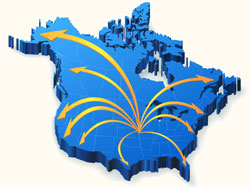Glossary
Arc
The curved portion of a bend.
Arc Length
The length of a bent/rolled surface.
Bend Radius
The arc of the bend itself, usually taken at the centerline. The distance from the center of curvature to the centerline (axis) of the pipe, expressed as a number multiplied by the pipe or tube size. For example, the bend radius of a 5 × D bend for a 2-inch nominal pipe size (NPS) pipe or a 2-inch tube is 10 inches (see centerline radius).
Center to Center
The distance between the theoretical or calculated centers of two adjoining bends on the same plane. Also used for diametric measurement between the centerlines of two tangent points of a bend (i.e. 180° bend, for which the center to center distance will be equal to twice the centerline radius).
Centerline Radius
The distance from the center of the curvature to the centerline (axis of the pipe.
Chord
The straight distance measured between the centerline points of any two points of a bend.
Cold Bending (“Pyramid” Rolling)
A steel member is placed in a machine and curved between three rolls.
Degree of Bend
The angle to which the bend if formed.
Diameter
A straight line passing through the center of a circle.
Distortion
A change from original shape and dimension. Note: Occurs in every rolled part to some degree.
Ductility
The ability of the material to deform without fracture. This is measured by elongation of reduction of area in a tensile test.
Hot Bending
Bending is achieved by applying heat directly to material by internal or external flame, or heating in a furnace.
Induction Bending
An electric coil heats a short section of a structural member, and then it is drawn through a process similar to rotary-draw and cooled with water directly after.
Off-Axis
Material rotated out of square in a cross sectional view.
Ovality
The distortion of the cross section of pipe or tube from its normal (round) shaped usually expressed as a percentage of the difference between major and minor axis.
Point Bending/Gag Pressing
Bending is achieved by applying a select number of point loads at varying increments along the length of the steel member.
Radius
A line segment that joins the center of a circle with any point on the materials circumference (see centerline radius).
Rise/Mid Ordinate
The distance of offset between the mid point of a chord and an arc, perpendicular to the chord.
Rotary-Draw Bending
The structural material is clamped into a die and then drawn around the die and over a mandrel until the bend if formed.
S-Curve
Bends occur in the same plane, but in opposite directions.
Slope
Calculated as the rise over the run of a segment.
Spirals
Bends occurs in a plan view with rise in elevation view.
Synchronized Incremental Cold Bending
performed by applying pressure in a highly synchronized fashion at several locations along the steel member.
Tangent
Straight section of material on either side of the bend or arc. May be any length. In order to make the bend itself, there has to be sufficient material at each end during the bending process. Excess may be trimmed after.
Tangent Point
The point at which the bend is started or ended.
Wall
The thickness of tubular materials, usually expressed as “nominal” or “minimum”.
Wall Thickness
The thickness of the material.
Wrinkles
Definite folds, creases or ripples formed on the surface of the pipe during bending operation.
Yield Point
The point at which material will deform permanently during bending.
Yield Strength
The stress at which a material exhibits a specified deviation.
© Copyright 2012 American Institute of Steel Construction. All Rights Reserved.

